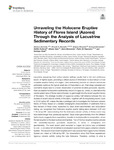Unraveling the Holocene Eruptive History of Flores Island (Azores) Through the Analysis of Lacustrine Sedimentary Records

Use este enlace para citar
http://hdl.handle.net/2183/41355Colecciones
- Investigación (FCIE) [1260]
Metadatos
Mostrar el registro completo del ítemTítulo
Unraveling the Holocene Eruptive History of Flores Island (Azores) Through the Analysis of Lacustrine Sedimentary RecordsAutor(es)
Fecha
2021-09-29Cita bibliográfica
Andrade, M., Ramalho, R. S., Pimentel, A., Hernández, A., Kutterolf, S., Sáez, A., ... & Giralt, S. (2021). Unraveling the Holocene eruptive history of Flores Island (Azores) through the analysis of lacustrine sedimentary records. Frontiers in Earth Science, 9, 738178
Resumen
[Abstract] Lacustrine sequences from active volcanic settings usually hold a rich and continuous record of tephra layers, providing a critical source of information to reconstruct a most complete eruptive history of a region. Lake sedimentary records on volcanic islands are particularly useful as the typical small size of these islands and their steep subaerial and submarine slopes lead to a lower preservation of potential erodible pyroclastic deposits. Here we explore the lacustrine sedimentary record of Lagoa da Lomba, a crater lake in the central upland area of Flores Island (Azores), to gain insight into the recent eruptive history of this island. The strategic location of Lagoa da Lomba, half distance between the two clusters of recent volcanic activity of the island, together with its long-lasting record, back to 23.52 cal kyr BP, makes this lake a privileged site to investigate the Holocene volcanic history of Flores. Based on a detailed stratigraphic characterization of sediments from a lake transect of three cores, supported by glass shard geochemistry and radiocarbon dating, we recognized four Holocene eruptive events taking place between 6.28 and 2.36 cal kyr BP, demonstrating that the Holocene volcanic activity at Flores Island may have lasted longer than previously reported. Glass shard geochemistry from the different tephra layers suggests three populations, basaltic to trachybasaltic in composition, where the last eruption is the least evolved endmember. Two of the four eruptive events correlate with subaerially-exposed pyroclastic sequences, in terms of stratigraphy and geochemistry. The most recent event recorded at Lagoa da Lomba was constrained to 3.66 – 2.36 cal kyr BP and linked to an eruption sourced from Lagoa Comprida Volcanic System. The second most recent eruptive event was sourced from Lagoa Funda Volcanic System and dated at 3.66 cal kyr BP. Our observations show that Flores experienced vigorous volcanic activity during the Late Holocene. Therefore, contrary to what is assumed, the possibility of future eruptions should be properly considered, and the volcanic hazard here should not be underestimated. Moreover, we highlight the importance of tephrostratigraphy in recent lake sediments to reconstruct past volcanic activity, especially at small volcanic islands, such as Flores, where exposure is poor due to erosion within the limited subaerial area and the dense vegetation
Palabras clave
Ocean island volcanoes
Lake tephrostratigraphy
Glass geochemistry
Holocene volcanism
Lagoa da lomba
Flores Island
Azores archipelago
Lake tephrostratigraphy
Glass geochemistry
Holocene volcanism
Lagoa da lomba
Flores Island
Azores archipelago
Versión del editor
Derechos
Atribución 3.0 España
ISSN
0377-0273






